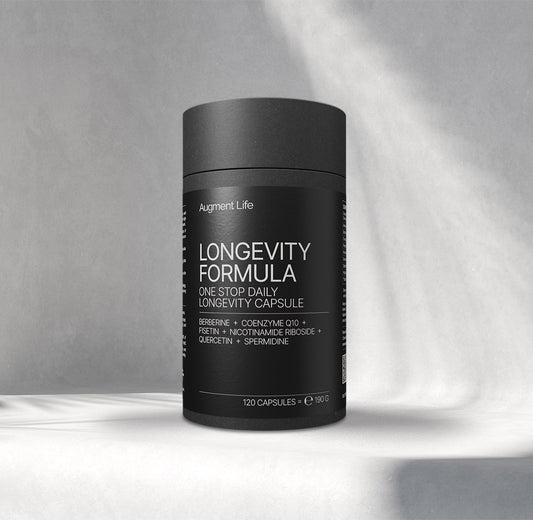Advanced glycation end products or AGEs are proteins and lipids with sugar residues attached to them. They are formed when we cook food at very high temperatures, especially when frying or roasting.
Unfortunately, they can be dangerous and cause a lot of damage to our tissues, organs and overall health. AGEs are even implicated in the development of several diseases, such as type II diabetes, cardiovascular disease, Alzheimer´s, and stroke. Overall, AGEs cause damage to every cell and cellular system in our bodies, and are one of the leading causes of aging, next to oxidative stress.
A lot of today´s scientific research is directed at finding out how to remove AGEs, or prevent them from causing damage. A lot of molecules show potential in inhibiting AGEs, such as metformin, resveratrol, and curcumin.
How are advanced glycation end products formed?
Advanced glycation end products (AGEs) can produced by our bodies or be found in some food groups in very small amounts. However, the most amounts of AGEs that we come into contact with today come from preparing food through frying, roasting, or cooking at high temperatures.
What happens is a form of caramelization called the Maillard reaction. Proteins and fats (lipids) react with sugar molecules from the food, and create protein-sugar and lipid-sugar compounds. As there are various types of sugars, proteins, and lipids, there are many kinds of AGEs that can be formed. Food high in fat and proteins, like animal meat and dairy, is especially prone to AGEs formation (1).
Only smaller AGEs are consumed through food, while bigger ones can be created in our bodies. It is currently not clear which of these AGEs are more dangerous.
Advanced glycation end products - examples
Some of the most famous AGEs that are formed through cooking are:
- Nϵ-carboxymethyl-lysine (CML),
- Nϵ-carboxyethyl-lysine (CEL),
- pyrraline,
- crossline,
- pentosidine,
- imidazolium cross-link derived from glyoxal and lysine-lysine (GOLD),
- imidazolium cross-link derived from methylglyoxal and lysine-lysine (MOLD).
These molecules also give food specific colors, taste, and aromas (2). One famous AGE produced naturally is called methylglyoxal (3).
Your AGEs intake will be higher if you always eat a lot of:
- fried/grilled/roasted meat, or fried food in general,
- butter and lard,
- full-fat dairy,
- processed foods.
Consider eating more fresh, uncooked or low-temperature foods, such as salads, vegetables, whole grains, soups, and stews. As an example, 1 fried egg has 1240 kilounits of AGEs, while 1 scrambled egg has only 75 kilounits of AGEs (4). You can find the full list of foods and guidelines on how to have a low-AGEs diet here.
Advanced glycation end products - symptoms
Having high levels of AGEs in our system can cause:
- advanced aging of the skin (wrinkling, loss of elasticity, dullness),
- increased levels of inflammation markers,
- damage to the vascular system,
- stiffness of the arteries,
- high blood pressure,
- high blood sugar,
- insulin resistance.
Prolonged high intake of AGEs through food can cause serious damage to your kidneys, heart, and vascular system.
Can advanced glycation end products be removed?
AGEs are metabolized by our bodies and excreted in urine. AGEs need to be broken down to peptides and free amino acids first, and some larger AGEs are harder to break. However, degraded AGEs products are usually more harmful than AGEs themselves, and can especially be harmful to kidneys of diabetic patients.
AGEs are a popular topic of research, and many scientific groups are trying to determine either how to prevent AGEs from forming, or how to remove them from our system. Unfortunately, there is not much research on human subjects yet, but there are multiple studies done in animal and cell models, like rats and mice.
These studies have found that substances like metformin, resveratrol and curcumin inhibit or prevent the negative effects of AGEs. For example, metformin stops AGES from forming (3), and curcumin binds itself to AGE-receptors in cells and inhibits leptin from secretion (4). Resveratrol may have a similar effect on the heart muscle, where it prevents tissue damage (5). These compounds have a lot of potential and represent an exciting new approach in the fight against AGEs.
Literature sources:
- Poulsen MW, Hedegaard RV, Andersen JM, de Courten B, Bügel S, Nielsen J, Skibsted LH, Dragsted LO. Advanced glycation endproducts in food and their effects on health. Food Chem Toxicol. 2013 Oct;60:10-37. doi: 10.1016/j.fct.2013.06.052.
- Chuyen NV. Toxicity of the AGEs generated from the Maillard reaction: on the relationship of food-AGEs and biological-AGEs. Mol Nutr Food Res. 2006 Dec;50(12):1140-9. doi: 10.1002/mnfr.200600144.
- Kalapos MP. Methylglyoxal in living organisms: chemistry, biochemistry, toxicology and biological implications. Toxicol Lett. 1999 Nov 22;110(3):145-75. doi: 10.1016/s0378-4274(99)00160-5.
- Uribarri J, Woodruff S, Goodman S, Cai W, Chen X, Pyzik R, Yong A, Striker GE, Vlassara H. Advanced glycation end products in foods and a practical guide to their reduction in the diet. J Am Diet Assoc. 2010 Jun;110(6):911-16.e12. doi: 10.1016/j.jada.2010.03.018.
- Dutta S, Shah RB, Singhal S, Dutta SB, Bansal S, Sinha S, Haque M. Metformin: A Review of Potential Mechanism and Therapeutic Utility Beyond Diabetes. Drug Des Devel Ther. 2023 Jun 26;17:1907-1932. doi: 10.2147/DDDT.S409373.
- Tang Y, Chen A. Curcumin eliminates the effect of advanced glycation end-products (AGEs) on the divergent regulation of gene expression of receptors of AGEs by interrupting leptin signaling. Lab Invest. 2014 May;94(5):503-16. doi: 10.1038/labinvest.2014.42.
- Mizutani K, Ikeda K, Yamori Y. Resveratrol inhibits AGEs-induced proliferation and collagen synthesis activity in vascular smooth muscle cells from stroke-prone spontaneously hypertensive rats. Biochem Biophys Res Commun. 2000 Jul 21;274(1):61-7. doi: 10.1006/bbrc.2000.3097.











